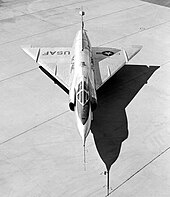Consolidated / Convair
F-102 Delta Dagger
 |
|
| General information | |
|---|---|
| Type | Interceptor aircraft |
| Manufacturer | Convair |
| Primary users | United States Air Force Hellenic Air Force / Turkish Air Force |
| Number built | 1,000 |
| History | |
| Introduction date | April 1956 |
| First flight | 24 October 1953 |
| Retired | 1979 |
| Developed from | Convair XF-92 |
| Developed into | Convair F-106 Delta Dart |
.
History Consolidated / Convair
Convair F-102 Delta Dagger
Introduction date April 1956, First flight 24 October 1953

The Convair F-102 Delta Dagger was an interceptor aircraft designed and produced by the American aircraft manufacturer Convair. A member of the Century Series, the F-102 was the first operational supersonic interceptor and delta-wing fighter operated by the United States Air Force (USAF).
The F-102 was designed in response to a requirement, known as the 1954 Ultimate Interceptor, produced by USAF officials during the late 1940s. Its main purpose was to be the backbone of American air defences and to intercept approaching Soviet strategic bomber fleets (primarily the Tupolev Tu-95) during the Cold War. The aircraft was designed alongside a sophisticated fire-control system (FCS); however, a simplified unit had to be adopted due to development difficulties. It used an internal weapons bay to carry both guided missiles and rockets. On 23 October 1953, the prototype YF-102 performed its maiden flight; however, it was destroyed in an accident only nine days later. The second prototype allowed flight testing to resume three months later, but results were disappointing: as originally designed, the aircraft could not achieve Mach 1 supersonic flight.
Background

On 8 October 1948, the board of senior officers of the United States Air Force (USAF) issued recommendations that the service organize a competition for a new interceptor scheduled to enter service in 1954; as such, the all-new design would initially be dubbed the "1954 Ultimate Interceptor". Four months later, on 4 February 1949, the USAF approved the recommendation and prepared to hold a corresponding competition during the following year. In November 1949, the USAF decided that the new aircraft would be built around a fire-control system (FCS). The FCS was to be designed before the airframe to ensure compatibility. The airframe and FCS together were called the weapon system.
In January 1950, the USAF's Air Materiel Command issued request for proposals (RFPs) to 50 companies for the FCS, of which 18 responded. By May, the list was revised downward to 10. Meanwhile, a board at the U.S. Department of Defense headed by Major General Gordon P. Saville reviewed the proposals, and distributed some to the George E. Valley-led Air Defense Engineering Committee. Following recommendations by the committee to the Saville Board, the proposals were further reduced to two competitors, Hughes Aircraft and North American Aviation. Although the Valley Committee thought it was best to award the contract to both companies, Hughes was chosen by Saville and his team on 2 October 1950
0
KmCeiling
0
KmCombat RANGE
0
MachAircraft Speed
0
Max Crew
Photo Gallery
Consolidated / Convair / Vultee
Convair F-102 Delta Dagger
Introduction date April 1956 First flight 24 October 1953


Consolidated Convair Vultee
Convair F-102 Delta Dagger
General characteristics
- Crew: 1
- Length: 68 ft 4 in (20.83 m)
- Wingspan: 38 ft 1 in (11.61 m)
- Height: 21 ft 2.5 in (6.464 m)
- Wing area: 695 sq ft (64.6 m2) conically cambered wing
-
-
-
- 661.5 sq ft (61.46 m2) YF-102
-
-
Powerplant
- Empty weight: 19,350 lb (8,777 kg)
- Gross weight: 24,494 lb (11,110 kg)
- Max takeoff weight: (14,288 kg)
- Fuel capacity: 1,085 US gal (903 imp gal; 4,110 L) internal + 2x 215 US gal (179 imp gal; 810 L) drop tanks
- Powerplant: 1 × Pratt & Whitney J57-P-25 afterburning turbojet engine, 11,700 lbf (52 kN) thrust dry, 17,000 lbf (76 kN) with afterburner
Specifications
- Maximum speed: 825 mph (1,328 km/h, 717 kn) at 40,000 ft (12,192 m)
- Maximum speed: Mach 1.25, Mach 0.95 with drop tanks
- Range: 1,350 mi (2,170 km, 1,170 nmi)
- Service ceiling: 53,400 ft (16,300 m)
- Rate of climb: 13,000 ft/min (66 m/s)
- Wing loading: 35 lb/sq ft (170 kg/m2)
Armament
- Rockets: 24 × 2.75 in (70 mm) FFAR (Folding Fin Aerial Rocket) unguided rockets in missile bay doors
-
Missiles:
- 6 × AIM-4 Falcon air-to-air missiles or
- 3 × AIM-4 Falcon
- 1 × AIM-26 Falcon with conventional or nuclear warhead
Links to Youtube & Others
During mid 1953, Convair concluded that it needed to take action to address the F-102's shortcomings to prevent its cancellation, and promptly embarked on a major redesign effort.
Convair F-102 Delta Dagger
The production F-102A had the Hughes MC-3 FCS, which was later upgraded in service to the MG-10; it was used to locate enemy targets,
Youtube Link
The Consolidated PT-1 Trusty (company designation Model 1) was a biplane primary trainer used by the United States Army Air Service (USAAS)












